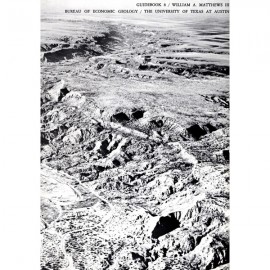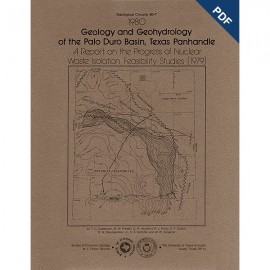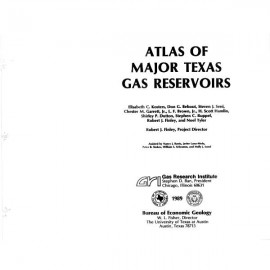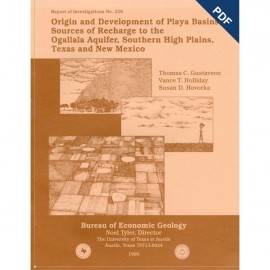Reports of Investigations
-
Books & Reports
- Reports of Investigations
- Guidebooks
- Udden Series
- Geological Circulars
- Down To Earth
- Atlases of Major Oil and Gas Reservoirs
- Texas Memorial Museum Publications
- Environmental Geologic Atlas of the Texas Coastal Zone
- Mineral Resource Circulars
- Other Reports
- Seminars and Workshops
- Handbooks
- Submerged Lands of Texas
- Symposia
- Annual Reports
- Open File Reports
-
Maps & Cross Sections
- Thematic Maps
- Miscellaneous Maps, Charts & Sections
- Geologic Atlas of Texas
- STATEMAP Project Maps
- Geologic Quadrangle Maps
- Cross Sections
- Highway Geology Map
- Energy and Mineral Resource Maps
- Shoreline Change and Other Posters
- Wilcox Group, East Texas, Geological / Hydrological Folios
- Bouguer Gravity Atlas of Texas
- River Basin Regional Studies
- Featured Maps
- Posters
- Teachers & the Public
-
Geological Society Publications
- Gulf Coast Association of Geological Societies
- Alabama Geological Society
- Austin Geological Society
- Corpus Christi Geological Society
- Houston Geological Society
- Lafayette Geological Society
- Mississippi Geological Society
- New Orleans Geological Society
- South Texas Geological Society
- GCS SEPM Publications
- Historic BEG & UT Series
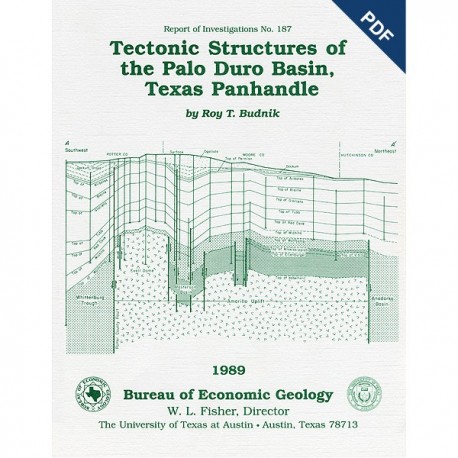
RI0187D. Tectonic Structures of the Palo Duro Basin, Texas Panhandle, by R. T. Budnik. 43 p., 31 figs., 1 table, 1989. doi.org/10.23867/RI0187D. Downloadable PDF.
To purchase this publication in book format, please order RI0187.
ABSTRACT
The Palo Duro Basin is a broad structural low in the southern Texas Panhandle that formed as a result of nearly continuous Pennsylvanian and Permian subsidence. True complexity of this basin is unknown because of the sparsity of structural information. However, surface and subsurface studies, including examinations of outcrop, well log, and seismic reflection data, indicate that structures within and adjoining the basin consist primarily of small, fault-bounded, isolated, positive basement areas and poorly defined subbasins. To the north, the Amarillo Uplift and subparallel Oldham-Harmon structural trend, together with the intervening Whittenburg Trough and Hollis Basin, form a complex zone of horsts and grabens that separates the Palo Duro and Anadarko Basins. The Matador Arch, an east-west-trending series of en echelon fault blocks, defines the southern edge of the Palo Duro Basin, and broad structural divides form the east and west margins of the basin.
Overall structural configuration of basins and uplifts of the southern Texas Panhandle and adjoining areas was produced during the Pennsylvanian Ancestral Rocky Mountain orogeny and modified by subsidence during the Permian and Triassic Periods. Some of the structures originated before the late Paleozoic and were later reactivated. Maximum topographic and bathymetric relief was attained in the Middle Pennsylvanian (Desmoinesian), when as much as 75 mi (120 km) of left-lateral movement took place along the Amarillo Uplift. Continuing deformation maintained a subtle differentiation between basins and uplifts through the end of the Permian and again in the Triassic. Tectonic activity during deposition of the Neogene Ogallala Formation occurred mainly along the Amarillo Uplift, but it subtly affected the entire Palo Duro Basin.
Dissolution of Permian evaporites in the Palo Duro Basin and adjoining areas has deformed overlying strata and complicated the documentation of tectonic activity. Structures formed by dissolution processes are confined to Upper Permian and younger strata in areas of thinned halite beds. In addition, surface structures produced by dissolution are chaotic in contrast with the more systematic character of those tectonically generated.
This study was undertaken to characterize the structural geology of the Palo Duro Basin. It was one facet of a larger project at the Bureau that was funded by the U.S. Department of Energy to assess the suitability of the basin as a location for a high-level nuclear waste repository. Although our understanding of the structural geology of the basin has been advanced by this study, additional data are needed before the nature of faults and folds in a given area of the basin can be predicted with precision.
Keywords: faults, neotectonics, New Mexico, radioactive waste, salt dissolution, structural analysis, structure-contour maps, synsedimentary processes, tectonic controls, Texas
Contents
Abstract
Introduction
Regional Setting
Stratigraphic Framework
Structures Marginal to the Palo Duro Basin
Amarillo Uplift
Whittenburg 'Trough
Oldham-Harmon Trend
Bravo Dome
Bush Dome
Donley positive
Plaska structure
Matador Arch
Structures in Eastern New Mexico
Roosevelt positive
Surface faults in eastern New Mexico
Alamosa Creek fault
Bonita fault
San Jon high
Garcia Lake high
Structures within the Palo Duro Basin
Castro County
Arney positive
Castro Trough
Central Randall County
Lamb County
Structures of Nontectonic Origin
Subsurface Structures
Surface Structures
Summary
Acknowledgments
References
Figures
1. Tectonic elements of West Texas and adjacent states
2. Stratigraphic column and general lithologies, Palo Duro Basin and Amarillo Uplift
3. Location of seismic lines in the Palo Duro Basin
4. Structure-contour map, top of basement, southern Texas Panhandle
5. Structure-contour map. top of basement, Amarillo Uplift
6. Basement lithologies in Castro County and in the Sun Oil Company No. 1 Herring well
7. Pre-Middle Devonian subcrop map and isopach map of the Arbuckle and Ellenburger Groups
8. Isolith map of Pennsylvanian and Lower Permian arkosic
9. Structure-contour map, top of the Alibates interval, Palo Duro Basin
10. South-north cross section A-A' of western Amarillo Uplift
11. Surface geology and structure-contour map of the base of the Ogallala Formation, western Amarillo Uplift
12. Photograph of Ogallala Formation outcrop
13. Photograph of basal Ogallala Formation gravels
14. South-north cross section B-B' and structure-contour map of the base of the Ogallala Formation in Carson County
15. Isopach map of the pre-Permian Palo Duro Basin
16. Isopach map of the Leonardian Series, showing the Whittenburg Trough and western Amarillo Uplift
17. Photograph of Rita Blanca beds (Pliocene) dipping southwestward into the Whittenburg Trough from the Channing Dome
18. Structure-contour map, top of the Tubb interval, Palo Duro Basin
19. Isopach map of the middle and Upper Permian, Palo Duro Basin
20. Isopach map of the Permian System, Palo Duro Basin
21. Percent carbonate in the Upper Pennsylvanian, Palo Duro Basin
22. Structure-contour map. top of basement, Matador Arch
23. Structure-contour map, top of the San Andres Formation, east-central New Mexico
24. West-east cross section C-C' of the Alamosa Creek fault
25. West-east cross section D-D' of the Bonita fault
26. West-east cross section E-E' of the Garcia Lake high
27. Isopach map of the Mississippian System, Palo Duro Basin
28. Cross sections, Castro Trough
29. Subsurface maps, Castro Trough
30. Seismic reflection profile G-G', central Randall high
31. West-east cross section H-H' of structural low in southern Lamb County
Table
1. Structural features within or adjoining the Palo Duro Basin
Citation
Budnik, R. T., 1989, Tectonic Structures of the Palo Duro Basin, Texas Panhandle: The University of Texas at Austin, Bureau of Economic Geology, Report of Investigations No. 187, 43 p.

